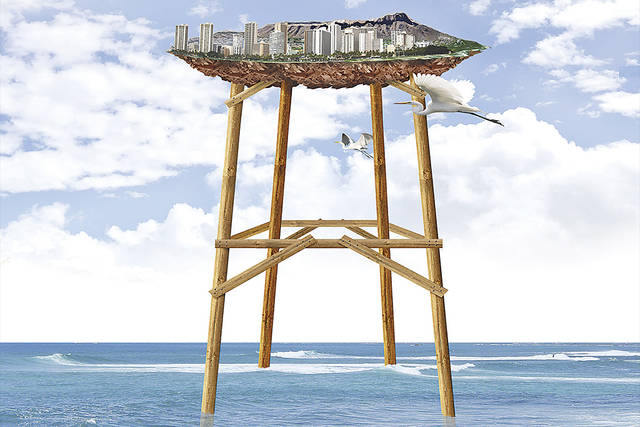Climate report paints dire picture for Hawaii

PHOTO ILLUSTRATION BY BRYANT FUKUTOMI / BFUKUTOMI@STARADVERTISER.COM
Extreme coastal flooding. Warmer temperatures. Extended periods of drought. Imperiled coral reefs. Hurricanes with greater intensity and consequence.
This is the world Hawaii will increasingly evolve into as climate change worsens over the next several decades, according to the Hawaii and U.S.-Affiliated Pacific Islands chapter of the fourth National Climate Assessment released Friday.
The severity of the impacts, the report says, depends on whether humans can get their act together and drastically reduce greenhouse gas emissions.
“This report is really scary,” said Josh Stanbro, Honolulu’s chief resilience officer. “It steps over a threshold of predicting what’s ahead to cataloguing the actual things we see all around us in real time. It’s showing that climate change is a clear and present danger.”
The section about Hawaii and the Pacific islands is part of a massive federal report that projects annual losses in some economic sectors reaching hundreds of billions of dollars by the end of the century. The U.S., it says, is already seeing the impacts of climate change in recent extreme weather disasters.
The Hawaii chapter was written by 11 scientists, along with 77 regional contributors, and is supported by citations from more than 250 published articles, reports and books.
Don't miss out on what's happening!
Stay in touch with breaking news, as it happens, conveniently in your email inbox. It's FREE!
The chapter lays out the changes already being felt in the islands, as well as what lies ahead, especially if current trends in greenhouse gas emissions continue.
“It’s definitely a warmer future,” said Victoria Keener of the East-West Center, the chapter’s lead author. “We can see it in the observed data, and it is reflected in the model projections.”
Some of the findings:
>> There will be many more hotter days and periods of drought that will reduce stream flow and water supply. Windward sides will be generally wetter and leeward sides much drier. More energy will be needed for air conditioning and to pump water to the dry areas. Storms will become more intense.
>> Changing weather patterns will cause ecosystems to shrink and native species to suffer, with some species going extinct.
>> Coastal development, infrastructure and beaches will come under increasing attack as the ocean rises. Across the state, nearly 550 Hawaiian cultural sites would be flooded or eroded, 38 miles of major roads would be chronically flooded and more than 6,500 structures and 25,800 acres of land near the shoreline would be unusable or lost, resulting in approximately 20,000 displaced residents in need of homes. More than $19 billion in damage in Hawaii is expected from sea level rise alone by 2100.
>> Increasing ocean temperatures and acidification will threaten fisheries, coral reefs and the livelihoods they support. Coral reef bleaching is likely to occur annually by midcentury, resulting in increasing reef mortality, and there will be lower fishery yields.
Another chapter author, Chip Fletcher, a University of Hawaii-Manoa oceanography professor and vice chairman of the city Climate Change Commission, said humans are engaged in a dangerous global experiment that threatens the foundation of human life on the planet.
A solid body of evidence, he said, indicates that greenhouse gases are raising Earth’s surface temperature with devastating consequences: heat waves, extreme weather, animal and plant extinctions, wildfires on the rise, melting glaciers, warmer oceans and sea level accelerating upward.
“Beginning literally now, humanity must cut its release of greenhouse gases by 50 percent before 2030, and another 50 percent in the following decade, and again in the next. Anything less will doom our children and their children to a world of deep drought, hundreds of millions of refugees, titanic hurricanes, shrinking food and water resources, and flooded cities,” Fletcher said.
Keener encouraged people to learn more about the causes of climate change, consider eating less meat, fly and drive less and vote for officials who support strong climate adaption and mitigation measures.
Doing your part for the climate is similar to voting, she said. You might not think your vote counts for much, but it very much does — as seen by recent elections.
“We can’t just keep living in a world of apathy,” Keener said.



